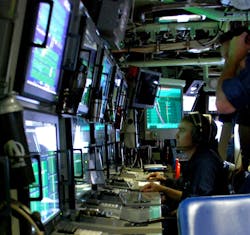Navy picks L3Harris KEO to supply motors for towed-array sonar aboard Virginia-class attack submarines
MECHANICSBURG, Pa. – U.S. Navy submarine sonar experts needed motors to extend and retract the TB-29 towed array sonar aboard Virginia-class fast attack submarines. They found their solution from L3Harris KEO in Northampton, Mass.
Officials of the Naval Supply Systems Command Weapon Systems Support activity in Mechanicsburg, Pa., has awarded a $19.9 million contract to L3Harris KEO for 22 Virginia-class thin-lined towed array motor assemblies.
Sonar designers at L3Harris and the Lockheed Martin Rotary and Mission Systems segment in Liverpool, N.Y. build versions of the TB-29 towed-array sonar.
TB-29C is the Navy’s next-generation thin line towed array passive sonar that has the same form factor to the TB-29A with improved reliability.
Related: L-3 to build six more TB-29A CTA towed array sonar systems for Virginia-class submarines
This next-generation TB-29C towed-array sonar will help Virginia-class attack submarines detect, track, and classify quiet, modern submarine threats in open ocean and littoral waters.
The TB-29C is a 416 channel thin line towed array with an equivalent acoustic performance capability to TB-29A. The TB-29C thin-line towed array sonar receiver that has the same form factor as the TB-29 array, yet offers increased capability, greater reliability and reduced obsolescence.
Towed array sonar uses hydrophones towed on a cable trailing behind a submarine or a surface ship; it can be miles long. It's designed to keep the array's sensors away from tow vessel noise to improve its signal-to-noise ratio and its ability to detect and track faint contacts like quiet nuclear- and diesel-powered submarines and seismic signals.
Towed array sonar uses hydrophones towed on a cable trailing behind a submarine or a surface ship; it can be miles long. It's designed to keep the array's sensors away from tow vessel noise to improve its signal-to-noise ratio and its ability to detect and track faint contacts like quiet nuclear- and diesel-powered submarines and seismic signals.
Effective use of towed array sonar systems limit a vessel's speed, and crews must take care to protect the cable from damage. Current towed-array systems also are complex designs and need to be upgraded to maintain reliability while deployed, while stowed, and while reeling the array in and out of submarines and other marine vessels.
L3Harris and Lockheed Martin also build the TB-29A Compact Towed Array (CTA) towed-array sonar. The TB-29A CTA offers significant reduction in sensor power, internal component diameter, bend radius, and production costs.
The TB-29A CTA submarine thin-line array is designed to reduce complexity, lower power, and improve robustness to withstand in-situ operations and stresses of handling systems, Navy officials say.
Its performance telemetry, acoustic sensors, and electronics are designed to provide a ubiquitous solution across the spectrum of submarine, surveillance, and unmanned towed arrays. This multi-mission commonality for these high-volume and unique components provides cost savings from procurement to life cycle support.
The TB-29A CTA provides the Navy with major technical advancements in towed array capabilities, Navy officials say. It can be used aboard attack, cruise-missile, and ballistic-missile submarines, as well as on unmanned surface vessels.
On this contract L3Harris KEO will do the work in Northampton, Mass., and should be finished by August 2026. For more information contact L3Harris L3Harris KEO online at https://www.l3harris.com/all-capabilities/naval-platform-imaging, or the Naval Supply Systems Command Weapon Systems Support activity in Mechanicsburg, Pa., at https://www.navsup.navy.mil/NAVSUP-Enterprise/NAVSUP-Weapon-Systems-Support/.
About the Author
John Keller
Editor-in-Chief
John Keller is the Editor-in-Chief, Military & Aerospace Electronics Magazine--provides extensive coverage and analysis of enabling electronics and optoelectronic technologies in military, space and commercial aviation applications. John has been a member of the Military & Aerospace Electronics staff since 1989 and chief editor since 1995.

